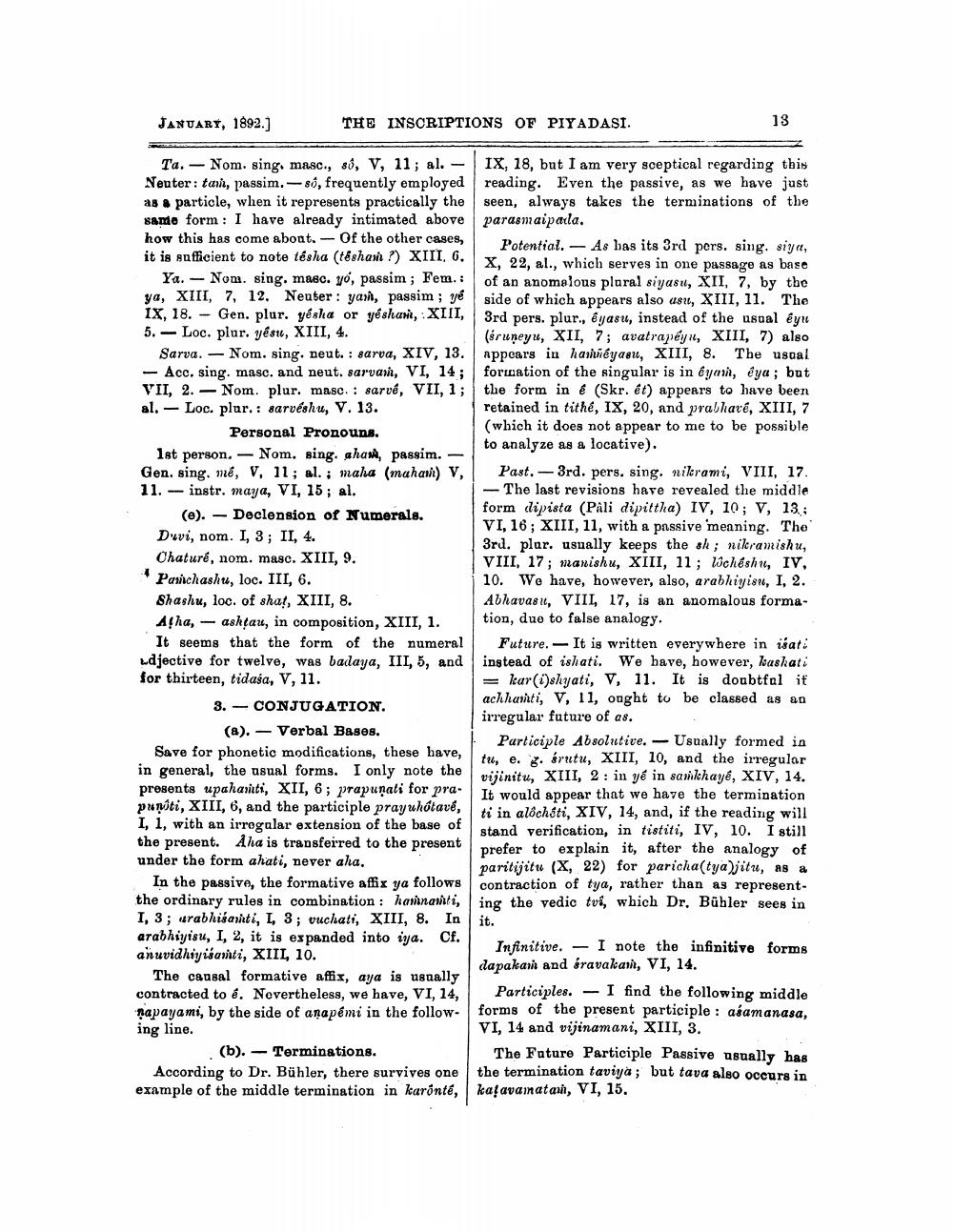________________
JANUARY, 1892.)
THE INSCRIPTIONS OF PIYADASI.
13
Ta.- Nom. sing. masc., só, V, 11; al. - IX, 18, but I am very sceptical regarding this Nenter: tani, passim.-- só, frequently employed reading. Even the passive, as we have just as a particle, when it represents practically the seen, always takes the terminations of the sande form : I have already intimated above parasmaipadla. how this has come aboat. - Of the other cases,
Potential. - As has its 3rd pers. sing. siya, it is sufficient to note tésha (téshan ?) XIII, 6.
X, 22, al., which serves in one passage as base Ya. - Nom. sing. masc. yo, passim ; Fem. :
of an anomalous ploral siyasu, XII, 7, by the ya, XIII, 7, 12, Neuter : yarı, passim ; yé side of which appears also asu, XIII, 11. The IX, 18. - Gen. plur. yesha or yéshan, XIII, 3rd pers. plur., @yasu, instead of the usual eyr 5.- Loc. plur. yesu, XIII, 4.
(śruneyu, XII, 7; avatrapéy, XIII, 7) also Sarva. — Nom. sing. neut. : sarva, XIV, 13. appears in hannñéyasu, XIII, 8. The usoal - Acc. sing. masc. and neut. sarvara, VI, 14; formation of the singular is in eyani, éya; but VII, 2.- Nom. plur. masc. : sarvé, VII, 1; the form in é (Skr. ét) appears to have been al. - Loc. plur. : sarveshu, V. 13.
retained in tithe, IX, 20, and prabharé, XIII, 7 Personal Pronouns.
(which it does not appear to me to be possible
to analyze as a locative). 1st person. - Nom. sing. ahant, passim. Gen. sing. me, V, 11; al.; maha (mahani) V, Past. - 3rd. pers. sing. nikerami, VIII, 17. 11. - instr. maya, VI, 15; al.
- The last revisions have revealed the middle
form dipista (Pali dipittha) IV, 10; V, 13; (e). - Declension of Numerals.
VI, 16; XIII, 11, with a passive meaning. The Duvi, nom. I, 3; II, 4.
3rd plur. usually keeps the sh; nilramishu, Chaturé, nom. masc. XIII, 9.
VIII, 17; manishu, XIII, 11 ; lúchésh, IV, Panchashu, loc. III, 6.
10. We have, however, also, arabhiyisu, I, 2. Shashu, loc. of shat, XIII, 8.
Abhavası, VIII, 17, is an anomalous formaAlha, -ashtau, in composition, XIII, 1.
tion, due to false analogy. It seems that the form of the numeral | Future. It is written everywhere in isati djective for twelve, was badaya, III, 5, and instead of ishati. We have, however, kaskati for thirteen, tidaśa, V, 11.
= kar(i)slyati, v, 11. It is doubtfal it
achhariti, V, 11, onght to be classed as an 3.- CONJUGATION.
irregular future of as. (a). – Verbal Bases.
Participle Absolutive. - Usually formed in Save for phonetic modifications, these have,
, tu, e. . brutu, XIII, 10, and the irregular in general, the usual forms. I only note the
vijinitu, XIII, 2: in yé in samkhayé, XIV, 14. presents upahanti, XII, 6; prapunali for pra.
It would appear that we have the termination punti, XIII, 6, and the participle praywhótavé,
ti in alôcháti, XIV, 14, and, if the reading will I, 1, with an irrogalar extension of the base of
stand verification, in tistiti, IV, 10. I still the present. Aha is transferred to the present
prefer to explain it, after the analogy of under the form ahati, never aha.
paritijitu (X, 22) for paricha(tyajitu, as a In the passive, the formative affix ya follows contraction of tya, rather than as representthe ordinary rules in combination : haninanti, ing the vedic tví, which Dr. Bühler sees in I, 3; arabhisarnti, I, 3; vuchati, XIII, 8. In arabhiyisu, I, 2, it is expanded into iya. Cf.
Infinitive. – I note the infinitive forms anuvidhiyisanti, XIIL 10.
dapakain and óravakarit, VI, 14. The causal formative affix, aya is usually contracted to é. Nevertheless, we have, VI, 14, Participles. - I find the following middle napayami, by the side of anapémi in the follow forms of the present participle : asamanasa. ing line.
VI, 14 and vijinamani, XIII, 3. (b). - Terminations.
The Future Participle Passive usually has According to Dr. Bühler, there survives one the termination taviya; but tava also occurs in example of the middle termination in karontē, kafavainatari, VI, 15.
it.




